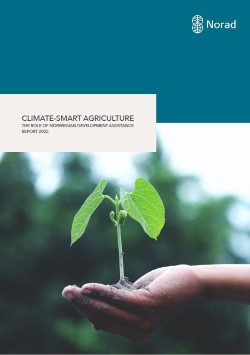Climate-smart agriculture: the role of Norwegian development assistance
About the publication
- Published: May 2022
- Series: --
- Type: --
- Carried out by: Carola Casti
- Commissioned by: --
- Country:
- Theme: Primary industry (agriculture fishing forestry), Climate and environment
- Pages: 50
- Serial number: --
- ISBN: 978-82-8369-106-1
- ISSN: --
- Organization: Norad

Climate-smart agriculture: the role of Norwegian development assistance
Climate change, food security and food systems are crucial and closely interlinked concepts, which have gained considerable attention, especially in the context of developing and foreign aid, given the global efforts to achieve the sustainable development goals (SDGs) by 2030, in accordance with the Paris Agreement.
Climate change affects every aspect of food security, particularly in the developing world, as the former interacts with other social, economic, demographic and institutional changes, by producing nonlinear outcomes (Sanga et al., 2021). Agriculture is at the heart of sustainable development (Chiriac et al., 2020): in Asia and SSA it contributes up to 15% of the GDP, and over 50% of employment in SSA regions (based on the 2019 World Development Indicators). Small-scale farmers are estimated to provide nearly 80% of the food produced in these regions, but they also tend to be more vulnerable to climate change and less able to cope with exogenous shock, such as pandemics (Chiriac et al., 2020).
An integrated approach that has been proposed as a feasible solution is “climate-smart agriculture» (CSA), which is based on three pillars: 1) sustainably increasing agricultural productivity and incomes, 2) adapting and building resilience to climate change, and 3) reducing and/or removing greenhouse gas emissions. This integrated and multifaceted context-dependent approach (Van Noordwijk et al., 2018), if efficiently designed and implemented, should lead to sustainable development and higher food security.
